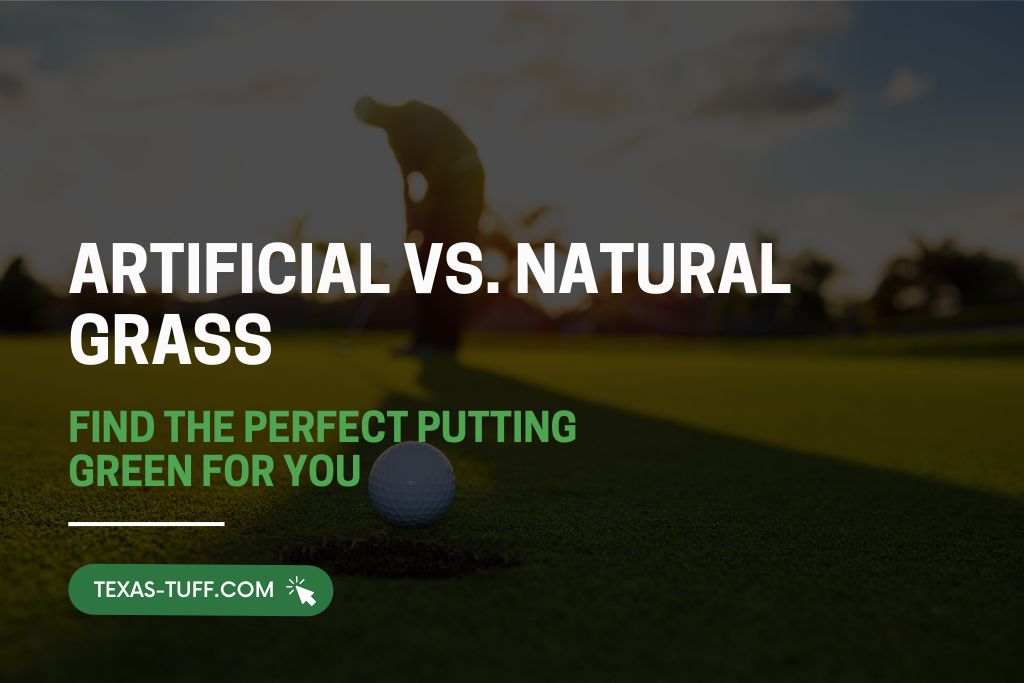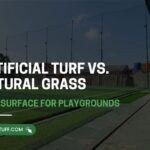If you’re dreaming of a backyard putting green, you’re on the right track. A well-designed green can provide hours of fun, improve your game, and add beauty to your outdoor space.
But not all putting greens are created equal. Choosing between artificial and natural grass makes a big difference in playability, maintenance, and overall enjoyment.
There are many factors to consider:
- Real grass for a natural look and feel
- Synthetic turf for low maintenance and consistent play
- Space and sunlight availability
- Your budget and long-term care preferences
Picking the wrong type can lead to frustration, uneven play, and extra costs down the line.
You don’t have to figure it out alone. In Dallas-Fort Worth, golfers have access to high-quality artificial turf and expert guidance to help create the perfect backyard putting green.
Texas Tuff artificial grass has helped hundreds of homeowners design putting greens that match their lifestyle and skill level. We’ll guide you through the key differences between artificial and natural grass so you can make a confident choice.
Choosing the right putting green can be simple, smart, and stress-free when you have the right information.
Table of Contents
What Are Your Perfect Putting Green Needs?
Before deciding between artificial and natural grass, it’s important to consider your priorities. Do you want a putting green that requires minimal upkeep, or are you looking for the authentic feel of natural grass under your feet?
Think about how you will use your green:
- Will it be a practice area for serious golf improvement or mainly for casual fun?
- How much time are you willing to spend on watering, mowing, and fertilizing?
- Do you have pets or children who might use the space as well?
- How much sunlight does the area receive throughout the day?
- What is your budget for installation and long-term maintenance?
Answering these questions will make it easier to determine the best option for your space.
The ideal putting green is one that matches your lifestyle, fits your yard, and provides consistent performance; whether it’s real grass that grows or artificial turf that stays perfect year-round.
Artificial Turf vs. Real Grass Putting Greens: 8 Key Factors to Consider
Choosing between artificial and natural grass affects playability, maintenance, and longevity. Here are eight key factors to consider:
Performance and Consistency
Choosing the right putting green means thinking about how the ball rolls and how consistent your practice can be. Natural and artificial options each have unique advantages.
Real Grass (Natural)
- Authenticity: Offers the most genuine look, feel, and subtle unpredictability, just like a world-class course.
- Consistency: Can be highly variable. Ball roll and speed depend on daily maintenance like mowing and rolling, as well as weather conditions and seasonal changes.
- Customization: Cup locations can be moved easily, allowing you to vary the challenge and create a more dynamic practice experience.
Artificial Turf (Synthetic)
- Consistency: Engineered for a perfectly true and uniform ball roll, speed, and minimal surface variation. Performance stays consistent all year round, rain or shine.
- Playability: High-quality turf can mimic the Stimpmeter speed of professional greens and allows for realistic chip shots that check and release naturally.
- Customization: Speed is set during installation based on turf material and infill amount, such as silica sand, and remains consistent over time.
Texas Tuff Pro Tip: For golfers looking for reliable, year-round practice, artificial turf is a top choice. If you want the authentic feel and don’t mind adjusting for maintenance and weather, natural grass can give you that true-course experience.
Maintenance Requirements
Keeping your putting green in top condition depends heavily on whether you choose natural or synthetic grass.
Real Grass (Natural)
- Intensive Upkeep: Maintaining a natural green requires significant time, knowledge, and specialized equipment.
- Tasks: Daily or near-daily mowing with a reel mower, constant watering, regular fertilizing, aeration, top-dressing, pest and disease control, and weeding.
- Time Commitment: Essentially demands the dedication of a part-time greenskeeper.
Artificial Turf (Synthetic)
- Minimal Upkeep: Artificial turf is virtually maintenance-free.
- Tasks: Occasional sweeping or leaf blowing to remove debris, periodic brushing to refresh fibers, and rinsing with a hose, especially important for pet areas.
- Time Commitment: Spend your time putting, not doing yard work.

Initial and Long-Term Cost
Cost is another major factor when choosing your putting green. Natural and artificial options differ significantly in both upfront and long-term expenses.
Real Grass (Natural)
- Initial Cost: Generally lower for basic installation, including soil preparation, sod or seed, and simple drainage.
- Long-Term Cost: Significantly higher due to recurring expenses like water bills, fertilizers, pesticides, fuel for mowing, specialized equipment, and professional maintenance services.
Artificial Turf (Synthetic)
- Initial Cost: Higher upfront due to premium turf materials, specialized infill, and extensive sub-base preparation such as grading and compacted aggregate for a true roll.
- Long-Term Cost: Very low once installed. Savings on water, chemicals, and labor often result in a lower total cost of ownership over its lifespan, which typically ranges from 15 to 25 years.
While natural grass may seem more affordable initially, artificial turf often delivers greater long-term value with less hassle, especially for dedicated golfers who want a consistent, low-maintenance green.
Durability and Longevity
How long your putting green stays in top condition depends on the type of grass you choose. Natural and artificial options vary greatly when it comes to resilience and lifespan.
Real Grass (Natural)
- Durability: Natural grass is highly susceptible to damage from heavy foot traffic, divots from clubs, pet use, and harsh weather conditions such as drought, frost, or heavy rain.
- Longevity: It requires constant repair and may need major reconstruction or replanting after just a few years of heavy use.
Artificial Turf (Synthetic)
- Durability: Artificial turf is engineered to resist wear and tear. It stands up to heavy traffic, intense UV rays, and diverse weather conditions without fading or degrading.
- Longevity: A high-quality installation can last 15–25 years with minimal performance loss, keeping your putting green consistent and reliable for decades.
For golfers who want a long-lasting, worry-free green, artificial turf is the smarter investment. Natural grass can offer authenticity but requires ongoing care to maintain durability and playability.
Weather Resilience and Playability
Your putting green should be ready whenever you are. Natural and synthetic options differ in how they handle weather conditions.
Real Grass (Natural)
- Climate Dependency: Requires a climate suitable for the chosen grass type, such as Bentgrass for cooler regions or Bermuda for warmer climates.
- Weather Impact: Can become muddy and unplayable after heavy rain. Extreme heat, drought, or winter frost may cause browning or dormancy, making year-round play difficult.
Artificial Turf (Synthetic)
- All-Weather Use: Engineered with superior drainage to allow near-immediate play even after heavy rainfall.
- Year-Round Play: Stays green and ready for use in all seasons and climates, from intense sun to frost.
Choose artificial turf for worry-free, year-round play—its superior drainage and durability keep your green ready in any weather.
Environmental Impact
Considering sustainability is key when choosing a putting green.
Real Grass (Natural)
- Water: Consumes significant water for irrigation, especially in dry climates.
- Chemicals: Needs regular fertilizers, herbicides, and pesticides, which can affect nearby water systems.
- Energy: Requires gas or electric-powered equipment for mowing and maintenance.
Artificial Turf (Synthetic)
- Water: Virtually eliminates irrigation needs, conserving a substantial amount of water.
- Chemicals: No fertilizers, herbicides, or pesticides required.
Materials: Made from synthetic, petroleum-based materials, though the long lifespan offsets some environmental costs.
Location Flexibility and Aesthetics
Where you can place your green and how it looks are important considerations.
Real Grass (Natural)
- Location: Needs adequate sunlight, proper soil, and good drainage—limited mostly to outdoor, ground-level areas.
- Aesthetics: Offers a classic look and natural scent, but neglect can result in patchy, inconsistent areas.
Artificial Turf (Synthetic)
- Location: Can be installed virtually anywhere: backyards, patios, rooftops, indoor spaces, or shaded areas where natural grass struggles.
- Aesthetics: Maintains a perfectly manicured green appearance year-round. Modern turf materials closely mimic the texture and color of natural grass.
User Experience (Pets, Kids, Cleanliness)
A putting green should be enjoyable for the whole household.
Real Grass (Natural)
- Cleanliness: Mud and dirt can easily be tracked indoors after rain.
- Pets/Kids: Prone to damage from pets digging or urine burns, as well as heavy play by children.
Artificial Turf (Synthetic)
- Cleanliness: Excellent drainage prevents mud and dirt. Pet messes can be rinsed away quickly.
- Pets/Kids: Highly durable and resistant to damage, eliminating the risks associated with lawn chemicals while withstanding heavy use.

Artificial vs. Natural Grass: Side-by-Side Comparison
To make choosing your putting green easier, here’s a quick overview of how artificial turf stacks up against natural grass across the most important factors:
|
Feature |
Real Grass (Natural) |
Artificial Turf (Synthetic) |
|
Authenticity |
True natural look, feel, and scent |
Modern turf closely mimics natural grass; feels soft underfoot |
|
Consistency |
Variable ball roll and speed depending on weather, maintenance, and season |
Predictable, true ball roll and speed year-round |
|
Maintenance |
Intensive: mowing, watering, fertilizing, aeration, pest control |
Minimal: occasional brushing, sweeping, and rinsing |
|
Durability |
Susceptible to foot traffic, pets, and harsh weather |
Highly resistant to wear, UV rays, and weather |
|
Longevity |
Requires frequent repairs; may need replanting after a few years |
15–25 years with minimal performance loss |
|
Weather Resilience |
Muddy or dormant in extreme conditions; seasonal play limitations |
Drains quickly; playable in all seasons and weather conditions |
|
Environmental Impact |
High water usage; chemical-dependent; energy-intensive maintenance |
Water-saving; no chemicals required; long-lasting synthetic materials |
|
Location Flexibility |
Needs sunlight, good soil, and drainage; limited to traditional outdoor areas |
Can be installed almost anywhere, including patios, rooftops, and shaded areas |
|
Pets & Kids |
Easily damaged; mud and dirt can track indoors |
Durable and safe; easy cleanup; resistant to pets and children |
|
Cost |
Lower initial cost; high ongoing maintenance costs |
Higher initial cost; very low long-term maintenance costs |
Consider your lifestyle, space, and long-term goals. If you want a worry-free, consistent green that performs beautifully year-round, artificial turf is the smart choice. For golfers seeking authenticity and willing to invest time and effort, natural grass offers the true-course experience.
Finding the Perfect Putting Green for You
Choosing between artificial and natural grass comes down to your priorities, lifestyle, and how you plan to use your space. Both options have unique advantages: natural grass delivers authenticity and a traditional feel, while artificial turf offers unmatched consistency, low maintenance, and year-round playability.
At Texas Tuff, we’ve helped hundreds of Dallas-Fort Worth homeowners create perfect backyard putting greens. From selecting the ideal turf to professional installation, we guide you every step of the way.
Whether you want a low-maintenance, year-round artificial green or the traditional feel of natural grass, we can help you design a putting green that meets your needs and exceeds your expectations.
Ready to start your dream putting green? Reach out to Texas Tuff today and let our experts help you find the perfect solution for your yard.
Frequently Asked Question
High-quality artificial turf typically lasts 15 to 25 years with minimal maintenance, retaining its color, texture, and playability throughout its lifespan.
Natural grass usually has a lower upfront cost but higher long-term expenses due to watering, mowing, fertilizing, and maintenance. Artificial turf has a higher initial cost but saves money over time.
Yes, artificial turf can be installed almost anywhere — including shaded yards, patios, rooftops, and indoor spaces. Natural grass needs sunlight, good soil, and proper drainage.
Natural grass can become muddy or dormant in extreme weather, limiting play. Artificial turf, on the other hand, is weather-resistant and playable year-round, even after heavy rain.







